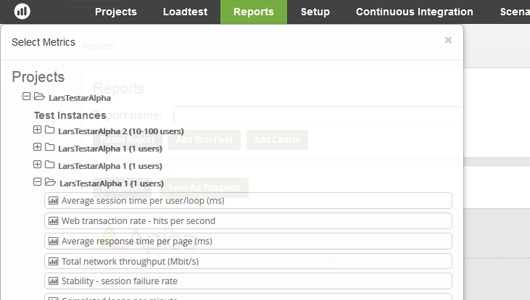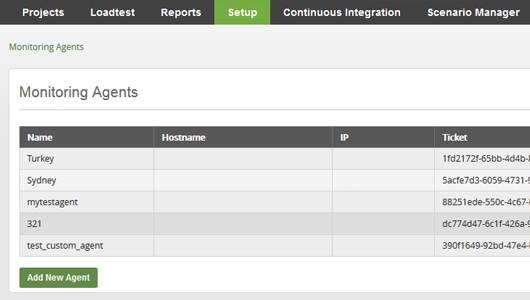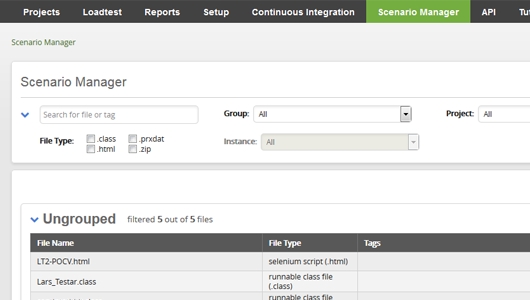Getting Started with ALT
Logging into Apica Loadtest (ALT):
Login at https://loadtest.apicasystem.com/

The ALT Portal Menu
Projects: A project is a named organization of load testing efforts that a Project Manager would want to assemble: Files, Test Instances (Tags, Number of Users, Start Date), People involved (technically and administratively) and who will get the results, Start-Completed Dates, Status, Business Unit, Test Category, Target Group, Environment (e.g. Production, Test, Development, Internal/External, Host Provider, etc), Application, Infrastructure, and Apica-related information will be recorded here.
Loadtest
New Test: As the name implies, here’s where you’d create a New Loadtest. You’d (1) select a subscription, (2) choose which script to use (or create a new script), (3) select Default or a saved test configuration, (4) Adjust any LT options (e.g. Duration, Location(s), and any other desired selections of the choices, (5) decide when to run the test (including immediately).
Create & Run Scenario: Create (Name it, attach it to a Project, Tag it, add job Comments) A Performance Scenario contains everything that relates to a performance test
One or more performance Scripts.
Parameter files
Load parameters that control how the load is applied
Infrastructure monitor agent configuration
Application Performance Management integration configuration
Test instance name (The name of the test results from a scenario test and must be unique to each project.)
Jobs: Find all your jobs here (Running, scheduled, and finished), with status for every job. Filter on projects, instances, or just do a search. Live results of Jobs can be reached by clicking on the link for a running job.

Reports: Create custom reports. Add the metric(s) you want to use in your report. If you want to compare that metric with other metrics, select several metrics, and add them to the same chart. To add several metrics to separate charts uncheck the checkbox labeled "Add to the Same Chart".

New Report: Use a template (which has a Project attached to it as well test instances pre-selected) or add a Chart/Table from a selection of Test Results, or add Subject and Body Text to the report.
Predefined Report: These are reports that have been created saved as templates that need to be filled in.
Create a Report from a Template, attach it to a Project, select the Test Instance, and Test Result to populate the template with.
Customize Reports:
Export a report with a new name, orientation, and format.
Name a Custom Design
Add/Remove a Logo
Add Header and Footer Text
Setup
Monitoring Agents: By using Monitoring Agents that are installed on your servers and collect metrics while you are running the loadtest you gain more insight from your environment. The agents are active only when your loadtest is actively running.

Under this menu, you can
Add a new group of agents
Create a new Agent (and add it to a group). NOTE: A new Authorization Ticket will be created for each monitoring agent.
Integration Settings
AppDynamics Settings: Add/Edit/Delete an AppD server for integration with Apica
URL
Account
User Name
Is Active?
Default App
New Relic Settings: Add/Edit/Delete a New Relic Account for integration with Apica
Account
API Key
Is Active?
Dynatrace Settings: Add/Edit/Delete a Dynatrace server for integration with Apica
URL
User Name
Is Active?
Continuous Integration With load testing in the Continuous Integration (CI) or Continuous Deployment (CD) process, you can be aware of your releases' performance earlier, before reaching production. And you can follow trends here by dividing every scenario's result into its own Test-Instance.
Result per script: Select the CI/CD metrics to display
Select the Project
Select the Loadtest Script
Select the Test Instance
Avg. Session Time compares the Average Session time for selected CI/CD metrics
Open image-20200708-193131.png
Scenario Manager:

A place to organize all your scenarios.
Group your scenarios for easier location.
Filter and tag them to make it easier to find the scenario.
Transfer scenarios easily to and from the LTP using the ZebraTester tool.
Scenario Manager Actions available:
Admin
Abuse Filter Rules: Set/enable pattern-matching rules (and exceptions to those rules) so you prevent load testing against unintended URL targets
Select User: Equivalent to the ASM Impersonate user. One way impersonation; you must log out and log back in to return if you have lesser rights.
Customers and Users: Search for and Manage Customers and Users
User Name
Full Name
Phone
Email
Region
Timezone
Available Actions
Edit Customer
Manage Subscriptions
Delete Customer
Sign in As User
Edit as User
Delete User
Messages: LTP system messages and announcements for users and customers with message active time period, with the importance (Critical, High, Low)
Available Admin Actions include Editing and deleting the Message
Upload Result: This is for uploading Prx Test Results (PRXRES data files) for inclusion in a project.
Monitoring Agents: Set up a new Linux agent in the database
Property Configuration: This panel allows you to set values for various categories within the Project. These Categories are listed in a drop-down box when accessing the project. The category values will change based on the selection beneath the dropdown. If the property values are not appropriate/listed, new, and multiple, values can be added to each category.
Exec Agent Manager: A place to manage all the agents you have access to.
Tab 1: Executing Agents. Search/filter for Executing Agents by
Filter: Executing Agent Name
Filter: Host IP or Hostname
Filter: Owning Customer Enabled?
Filter: Region
Filter: Show Disabled Agents
Delete an Agent
Add a New Agent.
Edit an existing Agent
Name (required)
Datacenter (required)
Host (IP or hostname) (required)
Max Users (required)
Visible to only one customer (select that customer)
Tab 2: Regions where you can filter for and edit agents by Region (as a country name, like ‘US’) or Country(Locale) (as a Language)
Example: Region= US returns
Whereas Locale = English (United States) returns
Tab 3: Datacenters where you can filter for and edit datacenters by Name, Geolocation, Coordinates, if Mobile, Locale (i.e. Language). Optionally you can Add a New Datacenter or edit an existing
Example: I want to edit the Amsterdam DC. All Orange asterisks are mandatory fields.
API: provides you access to your Load Testing Portal (LTP) API information
Your Authorization Token
Non-working Auth Token Example: 12A34B5C-DE67-1111-1G06-1014HIJK1L91
Your API URL Endpoint
Technical documentation leads you to the documentation for the Loadtest Portal API.
API Examples with CURL requests to the LTP API are provided for you here as well
The Tutorials menu connects to the Apica Knowledgebase Apica LoadTest Tutorials page.
The Scripting Tool menu leads to the Apica Knowledgebase Apica Scripting Tools Documentation page.
Last updated
Was this helpful?